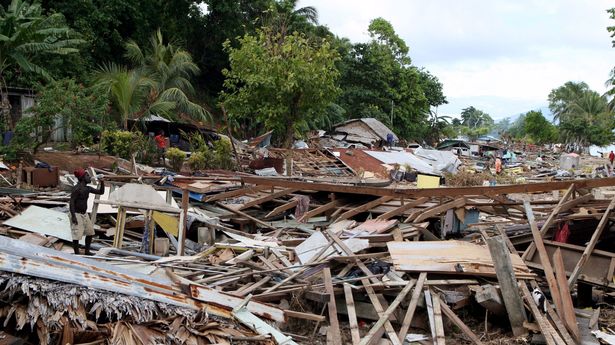As part of the Mirror’s NextGen International series, two teenagers describe how a night of celebration quickly turned into devastation when a cyclone destroyed their coastal village in the Solomon Islands

Image: EPA)
On New Year’s Eve 2018, our coastal village was torn apart by a devastating cyclone.
Before it arrived, the sky was crystal clear, the stars were twinkling and the calm ocean didn’t make a sound.
It was a perfect atmosphere for the celebrations; the smell of the roast chicken filled the air as our brothers and sisters drank and danced to music.
It was a truly joyful night until 30 minutes before the big countdown, when the weather suddenly changed.
Dark clouds filled the sky and a strong wind blew hard against our houses.
Huge storm surge waves roared and rolled speedily up the shorelines up into the mainland.
(
Image:
Collin Leafasia/Daily Mirror)
People were scared because many of our homes were made of temporary materials and were old – they would not survive a cyclone.
Waves smashed against the coral reefs and huge rocks from the sea were hurled towards the land, causing rubbish and debris to wash up on the shore.
Coconut trees were uprooted and thrown down, many coastal homes were destroyed.
The sea water and the rain water poured into the low-lying villages.
We were stunned at how quickly the weather changed as our new year celebrations came to a sombre end.
Some people were running around in a panic, carrying their luggage and other necessities to the church building, an evacuation hall for the community.
(
Image:
Collin Leafasia/Daily Mirror)
Others searched for higher grounds but some of us waited in our homes, shivering and scared.
Suddenly, the roof of our house blew off and the walls were damaged by the huge rolling waves, so we fled to the church for cover.
The storm battered our land all night.
On New Year’s morning, we broke cover and found the sea was calm and the winds had dropped, but our beautiful white sandy beach was covered with uprooted corals, dead fish and tree branches.
We lived temporarily with neighbours while we started to clean up and set up a new site to build a new house.
It took three months to rebuild our home, which we feared would be torn down again by the weather.
(
Image:
Collin Leafasia/Daily Mirror)
In response, the chief of the village and our people planted trees along the coastlines to stop flooding and dug wide drains behind the village to allow water to flow slowly to the sea during rainy seasons.
But there is only so much we can do to keep this weather at bay.
We expect weather like this during our rainy season, but in the past 40 years cyclones like these have become more intense and more destructive storms now form more often.
Warming oceans could also drive more dangerous cyclones like these.
We worry because it’s likely they will get bigger and more deadly as time goes by.
That’s why we need to come together and act now, before it’s too late.
(
Image:
Collin Leafasia/Daily Mirror)
Save the Children’s climate action in the Solomon Islands
The Solomon Islands is at the forefront of climate change despite the country contributing very little to global carbon emissions.
Children there are being taught to prevent and respond to the impact of climate change by charity Save the Children.
They’re taught how to protect their local environment and adapt to extreme weather and sea level rise that impacts their everyday lives.
Save the Children’s projects also aim to build the resilience of communities and the government as climate change increasingly damages the nation.
This includes setting up early warning systems for cyclones and planning disaster responses that protect schools, so students can continue their education even in emergencies.
Through special projects, the charity helps equip children to take the lead for developing solutions that address the impact of climate change, both now and in the future.
The NGO is also working with the United Nations’ Green Climate Fund to improve access to climate change impact data, which will help inform local and national governments.
Across the world, Save the Children is teaching children in schools and the broader community, on how they can develop preventative measures and take action to respond to the impacts of immediate and expected climate changes.


